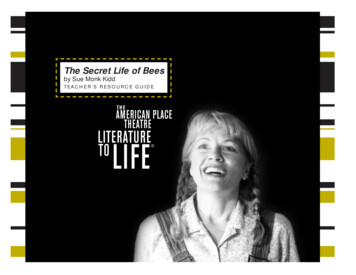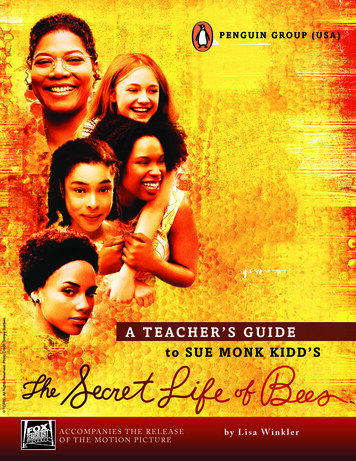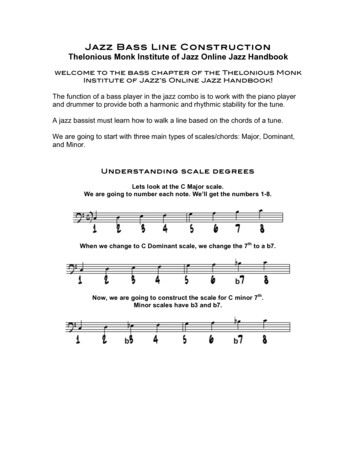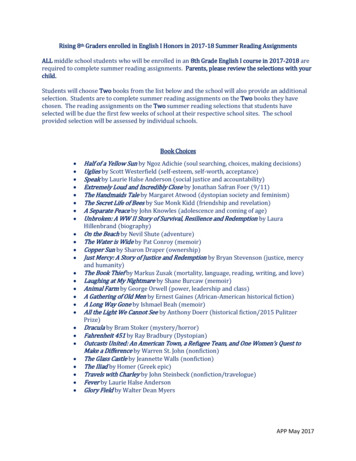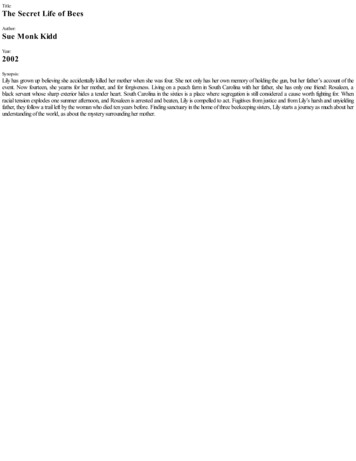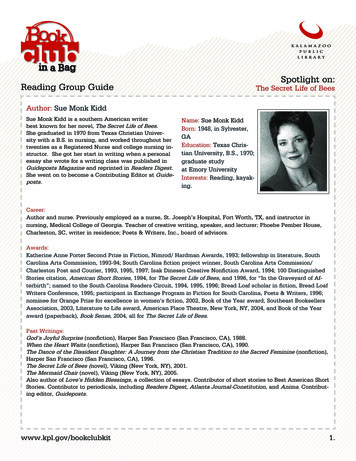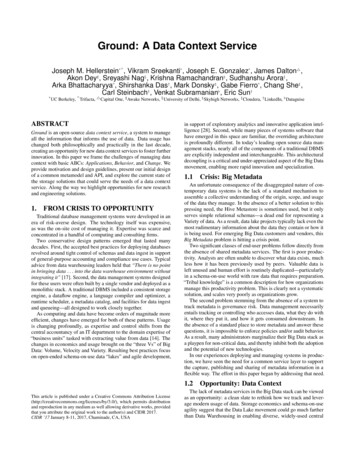
Transcription
SamplePrestwick HouseMultiple CriticalPerspectives Prestwick HouseTeaching Sue Monk Kidd’sThe Secret Life of Beesfrom Multiple Critical PerspectivesClick hereto learn moreabout thisMultiple CriticalPerspectives! Click hereto find moreClassroom Resourcesfor this title! Prestwick HouseMore from Prestwick HouseLiteratureLiterary Touchstone ClassicsLiterature Teaching UnitsGrammar and WritingCollege and Career Readiness: WritingGrammar for WritingVocabularyVocabulary Power PlusVocabulary from Latin and Greek RootsReadingReading Informational TextsReading Literature
Multiple CriticalPerspectivesTeaching Sue Monk Kidd'sThe Secret Life of BeesfromMultiple Critical Perspectives byRita Truschel
Multiple CriticalPerspectivesThe Secret Life of BeesGeneral Introduction to the WorkGenreTheSecret Life of Bees is a Bildungsroman. This is a German term for a novel about the growth ofthe leading character’s personality from youth to adulthood. Such stories also are called “coming-of-age” or “education” novels. The narrative follows the protagonist’s intellectual, moral, and psychologicaldevelopment to maturity. Mistakes and challenges in pursuit of a goal form this person’s identity or senseof self in relation to society.In The Secret Life of Bees, fourteen-year-old Lily Melissa Owens grows from a child to a youngadult without help from her parents. Lily faces the usual challenges of adolescence: a maturing body,relationships with the opposite sex, independence, identifying talents, choosing a career, and adjustingresponsibly to community life. In addition, she is haunted by her mother’s death in a gun accident. Herfather is bitter and uncommunicative.Lily lives in a rural South Carolina town in 1964, a period when women and black people facedsocial restrictions. Lily confronts injustice when the Owenses’ black housekeeper, Rosaleen, goes toregister to vote and is beaten by racists.As is typical in such novels, Lily leaves home to discover the truth about herself, her family, andher place in society. She and Rosaleen find refuge with the Boatwright sisters, who are black as well asfeminists. Lily overcomes challenges by using her own abilities, with aid from influential characters sheencounters. By the end of the novel, Lily has answered her essential questions about her parents andherself and found a new home, better relationships and adult goals.The Secret Life of Bees is structured as an extended flashback from the first-person point of viewof Lily, the protagonist and narrator. In effect, she looks back over the summer of 1964 to compare andcontrast who she was as a child to who she became as a young adult.A first-person viewpoint involves the narrator as a character in her or his own story. It can beidentified by use of “I” or “we” in the telling. This creates intimacy and concentrates on the protagonist’smotives, goals, and reactions.However, the first-person narrator may be unreliable. This principal character could be withholdingor misjudging information out of ignorance, faulty memory, bias or a need for self-protection.In The Secret Life of Bees, Lily Owens is an unreliable narrator for all these reasons. Lily was onlyfour years old when her mother died, so she cannot remember the fatal accident clearly. Lily is biasedagainst her temperamental father, and she refuses to believe that her mother might have abandoned her.For most of the novel, Lily protects herself from learning the truth about her imperfect mother and herparents’ unhappy marriage.6Pr e s t w i c kHo u s e,In c.
The Secret Life of BeesMultiple CriticalPerspectivesFormalism Applied toThe Secret Life of BeesNotes on the Formalist ApproachThe formalist approach to literaturewas developed at thebeginning of the 20th century and remained popular until the1970s, when other literary theories began to gain popularity. Today,formalism is generally regarded as a rigid and inaccessible means ofreading literature, used in Ivy League classrooms and as the subjectof scorn in rebellious coming-of-age films. It is an approach that isconcerned primarily with form, as its name suggests, and thus placesthe greatest emphasis on how something is said, rather than what issaid. Formalists believe that a work is a separate entity—not at alldependent upon the author’s life or the culture in which the workis created. No paraphrase is used in a formalist examination, and noreader reaction is discussed.Originally, formalism was a new and unique idea. The formalistswere called “New Critics,” and their approach to literature became thestandard academic approach. Like classical artists such as da Vinci andMichaelangelo, the formalists concentrated more on the form of the artrather than the content. They studied the recurrences, the repetitions,the relationships, and the motifs in a work in order to understand whatthe work was about. The formalists viewed the tiny details of a work asnothing more than parts of the whole. In the formalist approach, evena lack of form indicates something. Absurdity is in itself a form—oneused to convey a specific meaning (even if the meaning is a lack ofmeaning).The formalists also looked at smaller parts of a work tounderstand the meaning. Details like diction, punctuation, and syntaxall give clues.Pr e s t w i c kHo u s e,In c.15
The Secret Life of BeesMultiple CriticalPerspectivesActivity OneExamining flashbacks and interruptions to chronological order in The Secret Life of BeesNOTE: While completing Activity One does not necessitate the class’s also completing Activity Two, ActivityOne is a prerequisite for Activity Two.1. Copy and distribute the handouts: Charting Lily’s Plotline and The Secret Life of Bees: Main Plot andSubplot Graphic.2.Have students work individually, in pairs, or small groups of three or four.3. Have students follow the instructions on the Charting Lily’s plotline handout and complete a graphicof the main plotline.4. Have students note instances in which the narrative structure of the main plot places key narrativeelements out of their usual order: exposition introduction of conflict rising action (including complications) climax falling action denouement5.Reconvene the class and have students share their results.6.Discuss any serious discrepancies in student accounts of chronology student interpretation of narrative elementsNOTE: Students do not need to agree or come to consensus, but it is important to clear up any factual errorsin the chronology.7.Discuss the effects of flashbacks and other disruptions to chronological order in the main plot. How does the fact that the story is narrated by an adult looking back on her adolescence affectyour understanding of her character? Sympathy for her? How does the narrative structure affect your enjoyment of the plot (e.g., suspense, humor,satisfaction with the resolution, etc.)? Why? How does the narrative structure affect your understanding of the theme? In what way(s)?Pr e s t w i c kHo u s e,In c.19
The Secret Life of BeesMultiple CriticalPerspectivesFeminist Theory Appliedto The Secret Life of BeesNotes on the Feminist TheoryFeminism is an evolving philosophy, and its application in literatureis a relatively new area of study. The basis of the movement, bothin literature and society, is that the Western world is fundamentallypatriarchal (i.e., created by men, ruled by men, viewed through theeyes of men, and judged by men).In the 1960s, the feminist movement began to form a newapproach to literary criticism. Of course, women had already been writingand publishing for centuries, but the 1960s saw the rise of a feministliterary theory. Until then, the works of female writers (or works aboutfemales) were examined by the same standards as those by male writers(and about men). Women were thought to be less intelligent than men,at least in part because they generally received less formal education,and many women accepted that judgment. It was not until the feministmovement was well under way that women began examining old texts,reevaluating the portrayal of women in literature, and writing new worksto fit the developing concept of the “modern woman.”The feminist approach is based on finding and exposing suggestionsof misogyny (negative attitudes toward women) in literature. Feministsare interested in exposing the undervaluing of women in literature thathas long been accepted as the norm by both men and women. Theyhave even dissected many words in Western languages that reflect apatriarchal worldview. Arguing that the past millennia in the Westhave been dominated by men—whether the politicians in power or thehistorians recording it all—feminist critics believe that Western literaturereflects a masculine bias, and, consequently, represents an inaccurate andpotentially harmful image of women. In order to repair this image andachieve balance, they insist that works by and about women be added tothe literary canon and read from a feminist perspective.Pr e s t w i c kHo u s e,In c.35
The Secret Life of BeesMultiple CriticalPerspectivesActivity OneComparing character traits with expectations of gender in The Secret Life of Bees1.Copy and distribute the handout: Comparing Character Traits and Expectations.2. Divide the class into three groups or a number of groups divisible by three. Try to have both maleand female representation in each group.3. Have the groups divide the following six primary characters and six secondary characters so thateach group member has two, and each group will discuss all twelve characters.4. Have students examine the book for exposition and incidents that reveal character traits and genderexpectations for their characters. Lily Owens Rosaleen Daise Deborah Owens T. Ray Owens Brother Gerald Officer Avery Gaston August Boatwright June Boatwright May Boatwright Neil Zachary Taylor Clayton Forrest5.Have students list traits and qualities that their characters expect and value in women.6.Have students list traits and qualities that their characters expect and value in men.7.Have groups identify characters with similar personalities and outlooks.8.Have groups identify pairs of characters with contrasting personalities and outlooks.NOTE: These complements and contrasts might be female-female, male-male, or female-male.9. Have students discuss positive and negative connotations of character traits as represented in thenovel.10.Reconvene the class and allow each group to present its findings.Pr e s t w i c kHo u s e,In c.39
The Secret Life of BeesMultiple CriticalPerspectivesMythological/Archetypal ApproachApplied to The Secret Life of BeesNotes on the Mythological/Archetypal ApproachMythological, archetypal, and psychological criticism areall closely related. This is because Freud formulated manytheories around the idea of the social archetype, and his pupil, CarlJung, expanded and refined Freud’s theories into a more cross-culturalphilosophy.Critics who examine texts from a mythological/archetypalstandpoint are looking for symbols. Jung said that an archetype is “afigure.that repeats itself in the course of history wherever creativefantasy is fully manifested.” He believed that human beings wereborn with an innate knowledge of certain archetypes. The evidenceof this, Jung claimed, lies in the fact that some myths are repeatedthroughout history in cultures and eras that could not possibly havehad any contact with one another. Many stories in Greek and Romanmythology have counterparts in Chinese and Celtic mythology, longbefore the Greek and Roman Empires spread to Asia and northernEurope. Most of the myths and symbols represent ideas that humanbeings could not otherwise explain (the origins of life, what happensafter death, etc.). Every culture has a creation story, a-life-after-deathbelief, and a reason for human failings, and these stories—whenstudied comparatively—are far more similar than different.When looking for archetypes or myths, critics take note ofgeneral themes, characters, and situations that recur in literature andmyth. In modern times, traditional literary and mythological archetypesare successfully translated to film. For example, Jane Austen’s Emmawas adapted into the popular Hollywood film Clueless. By drawing onthose feelings, thoughts, concerns, and issues that have been a partof the human condition in every generation, modern authors allowreaders to feel that they know the characters in a work with very littlebackground information. Imagine how cluttered stories would be if theauthor had to give every detail about every single minor character thatentered the work!Pr e s t w i c kHo u s e,In c.53
The Secret Life of Bees3.Multiple CriticalPerspectivesArchetypal Situations the QUEST: the hero’s endeavor to establish his or her identity or fulfill his or her destiny.Variations on the QUEST can include: the Faustian bargain: the selling of one’s soul to the devil (metaphorically representing the notionthat one would “give anything” in order to ) in exchange for unlimited power, knowledge,wealth, etc. Examples include King Midas. the pursuit of revenge for a real or perceived wrong, as exemplified by Captain Ahab’s quest inMoby Dick. the descent into the underworld. (Note that this is usually one part of the quest rather than theentire quest itself.) the RENEWAL OF LIFE: death and rebirth, resurrection as seen in the cycle of the seasons, thephases of the day, sleeping and waking. Examples are “Sleeping Beauty,” “The Secret Garden,” etc. INITIATION: coming of age, rites of passage. Some examples include the first hunt, weddings,teenage angst films. THE FALL: any event that marks a loss of innocence, a devolution from a paradisial life orviewpoint to a tainted one. REDEMPTIVE SACRIFICE: any voluntary loss, especially a loss of life, that results in another’sgaining or regaining a desired state. the CATALOG OF DIFFICULT TASKS: (labors of Hercules, Cinderella’s treatment by herstepmother and stepsisters, etc.). the END OF THE WORLD: usually apocalyptic, involving warfare, a huge battle, a metaphoricfinal battle between good and evil.Pr e s t w i c kHo u s e,In c.57
The Secret Life of Bees Perspectives Activity One Comparing character traits with expectations of gender in The Secret Life of Bees 1. Copy and distribute the handout: Comparing Character Traits and Expectations. 2. Divide the class into three groups or a number of groups divisible by three. Try to have both male and female representation in .
